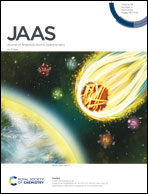Detection of surface contamination for particulate metals using spark emission spectroscopy†
Abstract
A new, field-portable method based on spark emission spectroscopy has been developed for on-site measurement of surface contamination for particulate metals. This method involves collection of a surface sample onto a piece of adhesive copper tape, followed by ablation and excitation by a spark discharge generated between a sharp electrode and the copper tape. The resulting atomic emissions are recorded using a spectrometer for elemental identification and quantification. The system was calibrated for Co, Cr, Fe and Mn using their characteristic emission lines. Detection limits were determined and found to be in the range of 3–19 ng cm−2 and measurement uncertainty was 35%. This approach was applied to the measurement of surfaces deposited with unknown loading of a welding fume sample, and results show a good agreement with those from standardized NIOSH method 9102. This method offers an alternative to the development of field-portable instruments for on-site, rapid determination of surface contamination for metals.



 Please wait while we load your content...
Please wait while we load your content...